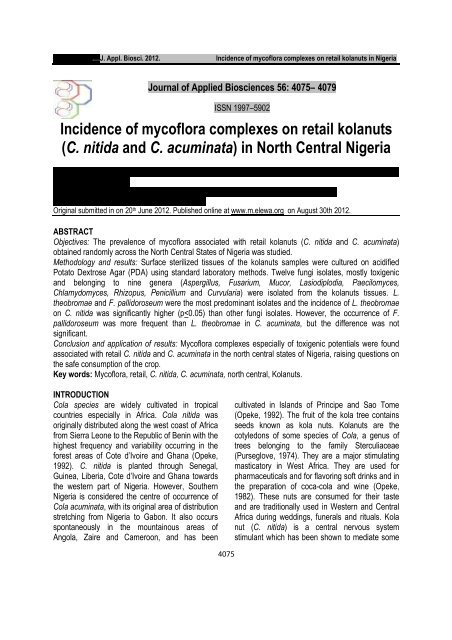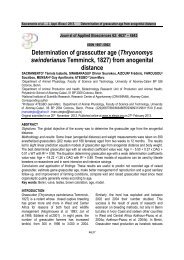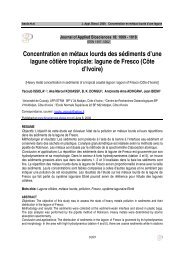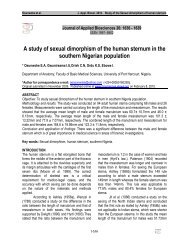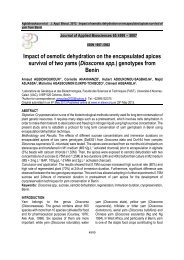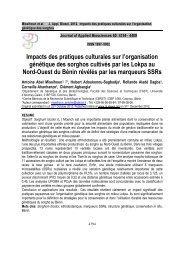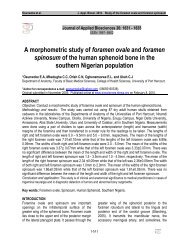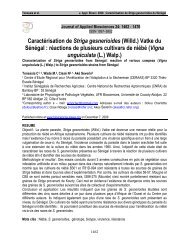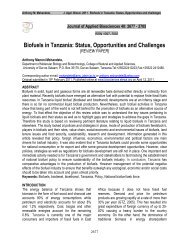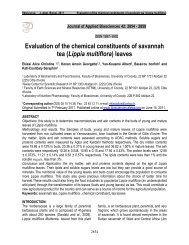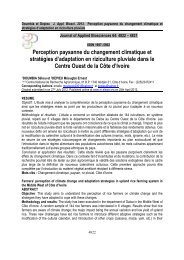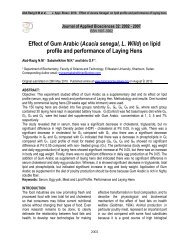Incidence of mycoflora complexes on retail kolanuts (C. nitida and C ...
Incidence of mycoflora complexes on retail kolanuts (C. nitida and C ...
Incidence of mycoflora complexes on retail kolanuts (C. nitida and C ...
Create successful ePaper yourself
Turn your PDF publications into a flip-book with our unique Google optimized e-Paper software.
Adeniyi et al. .…J. Appl. Biosci. 2012.<br />
<str<strong>on</strong>g>Incidence</str<strong>on</strong>g> <str<strong>on</strong>g>of</str<strong>on</strong>g> myc<str<strong>on</strong>g>of</str<strong>on</strong>g>lora <str<strong>on</strong>g>complexes</str<strong>on</strong>g> <strong>on</strong> <strong>retail</strong> <strong>kolanuts</strong> in Nigeria<br />
Journal <str<strong>on</strong>g>of</str<strong>on</strong>g> Applied Biosciences 56: 4075– 4079<br />
ISSN 1997–5902<br />
<str<strong>on</strong>g>Incidence</str<strong>on</strong>g> <str<strong>on</strong>g>of</str<strong>on</strong>g> myc<str<strong>on</strong>g>of</str<strong>on</strong>g>lora <str<strong>on</strong>g>complexes</str<strong>on</strong>g> <strong>on</strong> <strong>retail</strong> <strong>kolanuts</strong><br />
(C. <strong>nitida</strong> <strong>and</strong> C. acuminata) in North Central Nigeria<br />
Adeniyi D. O*, Kolawole O. O, Oduwaye O. F, Adejobi K. B, Adenuga O. O, Adepoju A. F, Olaniyi O.<br />
O <strong>and</strong> Anagbogu C. F.<br />
Cocoa Research Institute <str<strong>on</strong>g>of</str<strong>on</strong>g> Nigeria, Km 14, Ibadan-Ijebu Ode Road PMB 5244, Ibadan, Nigeria<br />
*Corresp<strong>on</strong>ding author: modeleadeniyi@gmail.com<br />
Original submitted in <strong>on</strong> 20 th June 2012. Published <strong>on</strong>line at www.m.elewa.org <strong>on</strong> August 30th 2012.<br />
ABSTRACT<br />
Objectives: The prevalence <str<strong>on</strong>g>of</str<strong>on</strong>g> myc<str<strong>on</strong>g>of</str<strong>on</strong>g>lora associated with <strong>retail</strong> <strong>kolanuts</strong> (C. <strong>nitida</strong> <strong>and</strong> C. acuminata)<br />
obtained r<strong>and</strong>omly across the North Central States <str<strong>on</strong>g>of</str<strong>on</strong>g> Nigeria was studied.<br />
Methodology <strong>and</strong> results: Surface sterilized tissues <str<strong>on</strong>g>of</str<strong>on</strong>g> the <strong>kolanuts</strong> samples were cultured <strong>on</strong> acidified<br />
Potato Dextrose Agar (PDA) using st<strong>and</strong>ard laboratory methods. Twelve fungi isolates, mostly toxigenic<br />
<strong>and</strong> bel<strong>on</strong>ging to nine genera (Aspergillus, Fusarium, Mucor, Lasiodiplodia, Paecilomyces,<br />
Chlamydomyces, Rhizopus, Penicillium <strong>and</strong> Curvularia) were isolated from the <strong>kolanuts</strong> tissues. L.<br />
theobromae <strong>and</strong> F. pallidoroseum were the most predominant isolates <strong>and</strong> the incidence <str<strong>on</strong>g>of</str<strong>on</strong>g> L. theobromae<br />
<strong>on</strong> C. <strong>nitida</strong> was significantly higher (p
Adeniyi et al. .…J. Appl. Biosci. 2012.<br />
<str<strong>on</strong>g>Incidence</str<strong>on</strong>g> <str<strong>on</strong>g>of</str<strong>on</strong>g> myc<str<strong>on</strong>g>of</str<strong>on</strong>g>lora <str<strong>on</strong>g>complexes</str<strong>on</strong>g> <strong>on</strong> <strong>retail</strong> <strong>kolanuts</strong> in Nigeria<br />
physiological effects that are similar to the acti<strong>on</strong> <str<strong>on</strong>g>of</str<strong>on</strong>g><br />
caffeine (Carrillo <strong>and</strong> Bennitez, 2000). Kola nut is<br />
chewed in Africa for its alkaloid properties which<br />
dispel sleep, thirst <strong>and</strong> hunger. The nuts are also<br />
used in the pharmaceutical <strong>and</strong> food industries to<br />
produce cardiac stimulants, laxatives, sedatives<br />
<strong>and</strong> sodas. The cultivati<strong>on</strong>, processing <strong>and</strong> storage<br />
<str<strong>on</strong>g>of</str<strong>on</strong>g> the nuts are undertaken in the warm, humid rain<br />
forest z<strong>on</strong>e where there is high mould infecti<strong>on</strong>.<br />
However, so highly esteemed are the nuts that<br />
fairly moldy samples are comm<strong>on</strong>ly ingested<br />
(Adebajo <strong>and</strong> Popoola, 2003).<br />
Mould growth is a vital problem encountered by<br />
farmers <strong>and</strong> <strong>retail</strong>ers in the process <str<strong>on</strong>g>of</str<strong>on</strong>g> preservati<strong>on</strong><br />
<strong>and</strong> storage <str<strong>on</strong>g>of</str<strong>on</strong>g> kolanut. Storage <str<strong>on</strong>g>of</str<strong>on</strong>g> kolanut has<br />
always been a laborious <strong>and</strong> delicate task. Kola<br />
traders were reportedly using the traditi<strong>on</strong>al<br />
methods <str<strong>on</strong>g>of</str<strong>on</strong>g> storage (Agbeniyi <strong>and</strong> Ayodele, 2010).<br />
However, kolanut <strong>retail</strong>ers have a measure <str<strong>on</strong>g>of</str<strong>on</strong>g><br />
regular removal <str<strong>on</strong>g>of</str<strong>on</strong>g> infested nuts during storage <strong>and</strong><br />
get them separated to c<strong>on</strong>trol <strong>and</strong> minimize<br />
spread. Peasant processing <strong>and</strong> packaging<br />
MATERIALS AND METHODS<br />
Collecti<strong>on</strong> <str<strong>on</strong>g>of</str<strong>on</strong>g> kolanut samples: Samples <str<strong>on</strong>g>of</str<strong>on</strong>g><br />
seemingly healthy <strong>kolanuts</strong> (C.<strong>nitida</strong> <strong>and</strong> C.<br />
acuminata) were purchased from <strong>retail</strong>ers in<br />
different locati<strong>on</strong>s in the North Central States <str<strong>on</strong>g>of</str<strong>on</strong>g><br />
Nigeria. The selected locati<strong>on</strong>s were; Ilorin <strong>and</strong><br />
Offa (Kwara), Kabba <strong>and</strong> Ayingba (Kogi), Gboko<br />
<strong>and</strong> Otukpo (Benue), Bida <strong>and</strong> Minna (Niger), Lafia<br />
<strong>and</strong> Akwanga (Nassarawa) <strong>and</strong> Jos <strong>and</strong> Barkin-<br />
Ladi (Plateau). The <strong>kolanuts</strong> samples were<br />
collected in a sterile polythene bags, labeled<br />
appropriately <strong>and</strong> assayed in-vitro within a week <str<strong>on</strong>g>of</str<strong>on</strong>g><br />
collecti<strong>on</strong>.<br />
Isolati<strong>on</strong> <strong>and</strong> Identificati<strong>on</strong> <str<strong>on</strong>g>of</str<strong>on</strong>g> myc<str<strong>on</strong>g>of</str<strong>on</strong>g>lora: The<br />
Potato Dextrose Agar (PDA) was routinely<br />
prepared in the laboratory <strong>and</strong> acidified with 10%<br />
lactic acid. With the use <str<strong>on</strong>g>of</str<strong>on</strong>g> sterilized scalpel, the<br />
kolanut samples were cut into small pieces <str<strong>on</strong>g>of</str<strong>on</strong>g><br />
about 3mm in diameter, surface sterilized in 2%<br />
Sodium hypochlorite for 2 minutes <strong>and</strong> rinsed in<br />
predisposes the kola nuts to mould c<strong>on</strong>taminati<strong>on</strong><br />
which is worsen especially during hawking.<br />
Odebode (1990) reported the susceptibility <str<strong>on</strong>g>of</str<strong>on</strong>g> kola<br />
nuts to fungal infecti<strong>on</strong>. However, Agbeniyi et al.<br />
(2000) observed that the c<strong>on</strong>taminati<strong>on</strong> <str<strong>on</strong>g>of</str<strong>on</strong>g> healthy<br />
nuts with spores from rotted nuts is <str<strong>on</strong>g>of</str<strong>on</strong>g>ten a greater<br />
ec<strong>on</strong>omic problem in fresh market producing<br />
areas. Botryodiplodia theobromae has been found<br />
to be the most comm<strong>on</strong> single species <str<strong>on</strong>g>of</str<strong>on</strong>g> pathogen<br />
associated with kola. Lasiodiplodia theobromae<br />
has also been described as the causal organism <str<strong>on</strong>g>of</str<strong>on</strong>g><br />
storage rot which is said to be the most severe<br />
post-harvest disease <str<strong>on</strong>g>of</str<strong>on</strong>g> kola nut. This fungus can<br />
also initiate latent infecti<strong>on</strong>s <strong>on</strong> nuts in the field<br />
when harvest is delayed, c<strong>on</strong>sequently resulting in<br />
rot during storage. Hence, mycotoxicoses is a<br />
serious c<strong>on</strong>cern, which is aggravated by<br />
reluctance <str<strong>on</strong>g>of</str<strong>on</strong>g> c<strong>on</strong>sumers to discard fairly moldy nut<br />
samples for its ec<strong>on</strong>omic value. The objective <str<strong>on</strong>g>of</str<strong>on</strong>g><br />
this study is therefore to establish the array <str<strong>on</strong>g>of</str<strong>on</strong>g><br />
myc<str<strong>on</strong>g>of</str<strong>on</strong>g>lora <str<strong>on</strong>g>complexes</str<strong>on</strong>g> associated with <strong>retail</strong><br />
<strong>kolanuts</strong> in the North central states <str<strong>on</strong>g>of</str<strong>on</strong>g> Nigeria.<br />
four changes <str<strong>on</strong>g>of</str<strong>on</strong>g> sterile distilled water. The<br />
sterilized tissues were blotted dry in between<br />
sterile Whatman No 1 filter paper (125mm) <strong>and</strong><br />
inoculated into petridishes c<strong>on</strong>taining about 20ml<br />
<str<strong>on</strong>g>of</str<strong>on</strong>g> solidified PDA. Each <str<strong>on</strong>g>of</str<strong>on</strong>g> the inoculated samples<br />
was replicated five times. The inoculated plates<br />
were incubated at 28+2 o C, col<strong>on</strong>y-growth was<br />
observed <strong>and</strong> emerging fungal col<strong>on</strong>ies were subcultured<br />
<strong>on</strong>to PDA plates to obtain pure cultures.<br />
The isolates were identified after microscopic<br />
examinati<strong>on</strong>s <strong>and</strong> fungi occurrence was recorded.<br />
Frequency <str<strong>on</strong>g>of</str<strong>on</strong>g> occurrence <str<strong>on</strong>g>of</str<strong>on</strong>g> the fungi isolates:<br />
The frequency <str<strong>on</strong>g>of</str<strong>on</strong>g> occurrence <str<strong>on</strong>g>of</str<strong>on</strong>g> the fungal isolates<br />
from the nuts <str<strong>on</strong>g>of</str<strong>on</strong>g> C. <strong>nitida</strong> <strong>and</strong> C. acuminata was<br />
determined by calculating the percentage<br />
frequency <str<strong>on</strong>g>of</str<strong>on</strong>g> occurrence <str<strong>on</strong>g>of</str<strong>on</strong>g> isolates by the formula:<br />
Freq. <str<strong>on</strong>g>of</str<strong>on</strong>g> Occurrence =<br />
No. <str<strong>on</strong>g>of</str<strong>on</strong>g> Plates c<strong>on</strong>taining Species × 100<br />
No. <str<strong>on</strong>g>of</str<strong>on</strong>g> Plates in Sample<br />
4076
Adeniyi et al. .…J. Appl. Biosci. 2012.<br />
<str<strong>on</strong>g>Incidence</str<strong>on</strong>g> <str<strong>on</strong>g>of</str<strong>on</strong>g> myc<str<strong>on</strong>g>of</str<strong>on</strong>g>lora <str<strong>on</strong>g>complexes</str<strong>on</strong>g> <strong>on</strong> <strong>retail</strong> <strong>kolanuts</strong> in Nigeria<br />
RESULTS<br />
Twelve (12) fungi isolates were cultured from the<br />
C. <strong>nitida</strong> <strong>and</strong> C. acuminata samples. They include<br />
Lasiodiplodia theobromae, Aspergillus niger, A.<br />
flavus, A. fumigatus, Mucor spinosus,<br />
Paecilomyces variotii, Chlamydomyces sp.,<br />
Rhizopus spp. F. pallidoroseum, F. m<strong>on</strong>iliforme,<br />
Penicillium sp. <strong>and</strong> Curvularia sp. (Table 1).<br />
Table 1: Myc<str<strong>on</strong>g>of</str<strong>on</strong>g>lora distributi<strong>on</strong> <str<strong>on</strong>g>of</str<strong>on</strong>g> sample locati<strong>on</strong>s<br />
Fungi Ilorin Offa Kabba Ayingba Gboko Otukpo Bida Minna Lafia Akwanga Jos Barkin-<br />
Ladi<br />
A. niger + - + - + - + + - + - +<br />
A. flavus - - - + - - - - + + + -<br />
A. fumigatus - - + + - - + + - - + +<br />
F.pallidoroseum + + + - + + - + - + - -<br />
F. m<strong>on</strong>iliforme + + + - + - + + + - + +<br />
M. spinosus + - + - - - - - - - - +<br />
L. theobromae + + + - + + + - + + - +<br />
P. variotii + + - - - - - - - - - -<br />
Chlamydomyces + - - - - - - - - + - -<br />
sp.<br />
Rhizopus spp. - - + - + + + + + - - +<br />
Penicillium sp. + - + + + - - + - + - -<br />
Curvularia sp. + + + + - - + - - - - -<br />
Present (+), Absent (-)<br />
L. theobromae <strong>and</strong> F. m<strong>on</strong>iliforme were isolated in<br />
nine locati<strong>on</strong>s within the selected areas. A. niger,<br />
Rhizopus spp. <strong>and</strong> F. pallidoroseum were found in<br />
seven <str<strong>on</strong>g>of</str<strong>on</strong>g> the locati<strong>on</strong>s. Penicillium spp. <strong>and</strong> A.<br />
fumigatus occurred in six locati<strong>on</strong>s, while<br />
Curvularia spp was intercepted in five locati<strong>on</strong>s. A.<br />
flavus was also isolated in four locati<strong>on</strong>s. However,<br />
each <str<strong>on</strong>g>of</str<strong>on</strong>g> P. variotii <strong>and</strong> Chlamydomyces spp. were<br />
found in two locati<strong>on</strong>s. Generally, the highest<br />
incidence <str<strong>on</strong>g>of</str<strong>on</strong>g> fungi <str<strong>on</strong>g>complexes</str<strong>on</strong>g> associated with the<br />
kola nuts samples was found in Kwara State. The<br />
analysis <str<strong>on</strong>g>of</str<strong>on</strong>g> the data obtained from the study<br />
showed that the fungi isolates cultured from C.<br />
<strong>nitida</strong> differ significantly (p
Adeniyi et al. .…J. Appl. Biosci. 2012.<br />
<str<strong>on</strong>g>Incidence</str<strong>on</strong>g> <str<strong>on</strong>g>of</str<strong>on</strong>g> myc<str<strong>on</strong>g>of</str<strong>on</strong>g>lora <str<strong>on</strong>g>complexes</str<strong>on</strong>g> <strong>on</strong> <strong>retail</strong> <strong>kolanuts</strong> in Nigeria<br />
L. theobromae was significantly higher than other<br />
fungi isolates <strong>and</strong> there was no significant<br />
difference between the occurrence <str<strong>on</strong>g>of</str<strong>on</strong>g> A. flavus <strong>and</strong><br />
F. pallidoroseum. The occurrence <str<strong>on</strong>g>of</str<strong>on</strong>g> F.<br />
m<strong>on</strong>iliforme, A. niger, M. spinosus, P. variotii,<br />
Penicillium sp <strong>and</strong> Rhizopus spp. were not<br />
significantly different from each other. Curvularia<br />
spp <strong>and</strong> Chlamydomyces spp were also not<br />
significantly different in their occurrence. However,<br />
the incidence <str<strong>on</strong>g>of</str<strong>on</strong>g> A. fumigatus was not observed in<br />
C. <strong>nitida</strong>. Unlike the observati<strong>on</strong> made from C.<br />
<strong>nitida</strong>, the incidence <str<strong>on</strong>g>of</str<strong>on</strong>g> L. theobromae <strong>and</strong> F.<br />
pallidoroseum differ significantly (p
Adeniyi et al. .…J. Appl. Biosci. 2012.<br />
<str<strong>on</strong>g>Incidence</str<strong>on</strong>g> <str<strong>on</strong>g>of</str<strong>on</strong>g> myc<str<strong>on</strong>g>of</str<strong>on</strong>g>lora <str<strong>on</strong>g>complexes</str<strong>on</strong>g> <strong>on</strong> <strong>retail</strong> <strong>kolanuts</strong> in Nigeria<br />
Journal <str<strong>on</strong>g>of</str<strong>on</strong>g> Biotechnology Vol. 2 (10), pp.<br />
369-373.<br />
Adebajo, LO <strong>and</strong> Popoola OJ (2003). Myc<str<strong>on</strong>g>of</str<strong>on</strong>g>lora<br />
<strong>and</strong> mycotoxins in <strong>kolanuts</strong> during storage.<br />
African Journal <str<strong>on</strong>g>of</str<strong>on</strong>g> Biotechnology Vol. 2<br />
(10), pp. 365-368.<br />
Agbeniyi SO <strong>and</strong> Fawole B (1999). Effects <str<strong>on</strong>g>of</str<strong>on</strong>g><br />
curing <strong>and</strong> pre-storage die treatments <strong>on</strong><br />
mould <str<strong>on</strong>g>of</str<strong>on</strong>g> <strong>kolanuts</strong>. Eur. J. Food Res.<br />
Technol., 208: 447-449.<br />
Agbeniyi SO <strong>and</strong> Ayodele MS (2010). Effect <str<strong>on</strong>g>of</str<strong>on</strong>g><br />
Storage Moulds <strong>on</strong> the Nutriti<strong>on</strong>al Quality<br />
<str<strong>on</strong>g>of</str<strong>on</strong>g> Kolanuts in Nigeria. Pakistan Journal <str<strong>on</strong>g>of</str<strong>on</strong>g><br />
Nutriti<strong>on</strong> 9 (6): 512-515.<br />
Agbeniyi SO (2004). Post Harvest <str<strong>on</strong>g>Incidence</str<strong>on</strong>g> <strong>and</strong><br />
c<strong>on</strong>trol <str<strong>on</strong>g>of</str<strong>on</strong>g> fungi associated with Kola nuts<br />
(Cola <strong>nitida</strong> (Vent) Schott <strong>and</strong> Endl. <strong>and</strong><br />
Cola acuminata (Brenan) Schott <strong>and</strong><br />
Endl.). Department <str<strong>on</strong>g>of</str<strong>on</strong>g> Biological Sciences,<br />
University <str<strong>on</strong>g>of</str<strong>on</strong>g> Agriculture, Abeokuta,<br />
November, 2004. PhD thesis.<br />
Agbeniyi, SO, Otu<strong>on</strong>ye HA <strong>and</strong> Adedeji AR (2000).<br />
Myc<str<strong>on</strong>g>of</str<strong>on</strong>g>lora associated with Post Harvest<br />
Processing Stages <str<strong>on</strong>g>of</str<strong>on</strong>g> Kola nuts (Cola<br />
<strong>nitida</strong> Vent Schott <str<strong>on</strong>g>of</str<strong>on</strong>g> Endlicher). The<br />
Journal <str<strong>on</strong>g>of</str<strong>on</strong>g> food Technology in Africa. Vol.<br />
5, No 4. pp. 129 – 131.<br />
Carrillo JA <strong>and</strong> Bennitez J (2000). Clinically<br />
significant pharmacokinetic interacti<strong>on</strong>s<br />
between dietary caffeine <strong>and</strong> medicati<strong>on</strong>s.<br />
Clin. Pharmacokinet., 39 (12), 127-153.<br />
D<strong>on</strong>go LN, Manjula K <strong>and</strong> Orisajo SB (2007).<br />
Occurrence <str<strong>on</strong>g>of</str<strong>on</strong>g> Ochratoxin A in Nigerian<br />
kola nuts. African Crop Science<br />
C<strong>on</strong>ference Proceedings Vol. 8. pp. 2133-<br />
2135.<br />
Odebode AC (1990). Post Harvest rot <str<strong>on</strong>g>of</str<strong>on</strong>g> kola nuts<br />
caused by Botryodiplodia theobromae <strong>and</strong><br />
Fusarium pallidoroseum. PhD Thesis<br />
University <str<strong>on</strong>g>of</str<strong>on</strong>g> Ibadan.<br />
Olunloyo, O. A. (1979). Fungi associated with<br />
stored kola nuts. Nig. J. Agric. Sci., 1(1):<br />
51-59.<br />
Opeke LK (1982). Tropical tree crops, Spectrum<br />
Books Ltd., Ibadan, pp. 124 – 174<br />
Purseglove JW (1974). Tropical Crops:<br />
Dicotyled<strong>on</strong>s, L<strong>on</strong>gman, Singapore, pp.<br />
564 – 570<br />
4079


